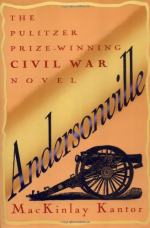The three songs most popular at the South, and generally regarded as distinctively Southern, were “The Bonnie Blue Flag,” “Maryland, My Maryland,” and “Stonewall Jackson Crossing into Maryland.” The first of these was the greatest favorite by long odds. Women sang, men whistled, and the so-called musicians played it wherever we went. While in the field before capture, it was the commonest of experiences to have Rebel women sing it at us tauntingly from the house that we passed or near which we stopped. If ever near enough a Rebel camp, we were sure to hear its wailing crescendo rising upon the air from the lips or instruments of some one more quartered there. At Richmond it rang upon us constantly from some source or another, and the same was true wherever else we went in the so-called Confederacy.
All familiar with Scotch songs will readily recognize the name and air as an old friend, and one of the fierce Jacobite melodies that for a long time disturbed the tranquility of the Brunswick family on the English throne. The new words supplied by the Rebels are the merest doggerel, and fit the music as poorly as the unchanged name of the song fitted to its new use. The flag of the Rebellion was not a bonnie blue one; but had quite as much red and white as azure. It did not have a single star, but thirteen.
Near in popularity was “Maryland, My Maryland.” The versification of this was of a much higher Order, being fairly respectable. The air is old, and a familiar one to all college students, and belongs to one of the most common of German household songs:
O,
Tannenbaum! O, Tannenbaum, wie tru sind deine
Blatter!
Da
gruenst nicht nur zur Sommerseit,
Nein,
auch in Winter, when es Schneit, etc.
which Longfellow has finely translated,
O, hemlock tree! O, hemlock tree! how faithful
are thy branches!
Green not alone in Summer time,
But in the Winter’s float and rime.
O, hemlock tree O, hemlock tree! how faithful are
thy branches. etc.
The Rebel version ran:
Maryland.
The despot’s heel is on thy shore,
Maryland!
His touch is at thy temple door,
Maryland!
Avenge the patriotic gore
That flecked the streets of Baltimore,
And be the battle queen of yore,
Maryland! My Maryland!




